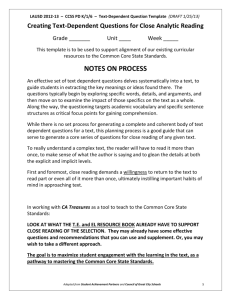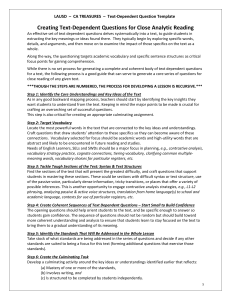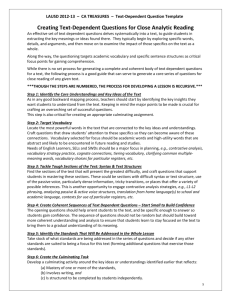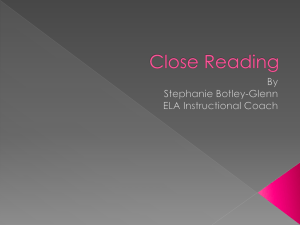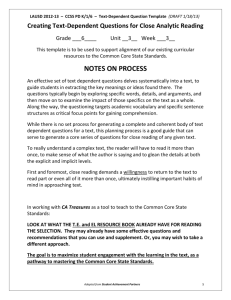6-U3-WK 2
advertisement
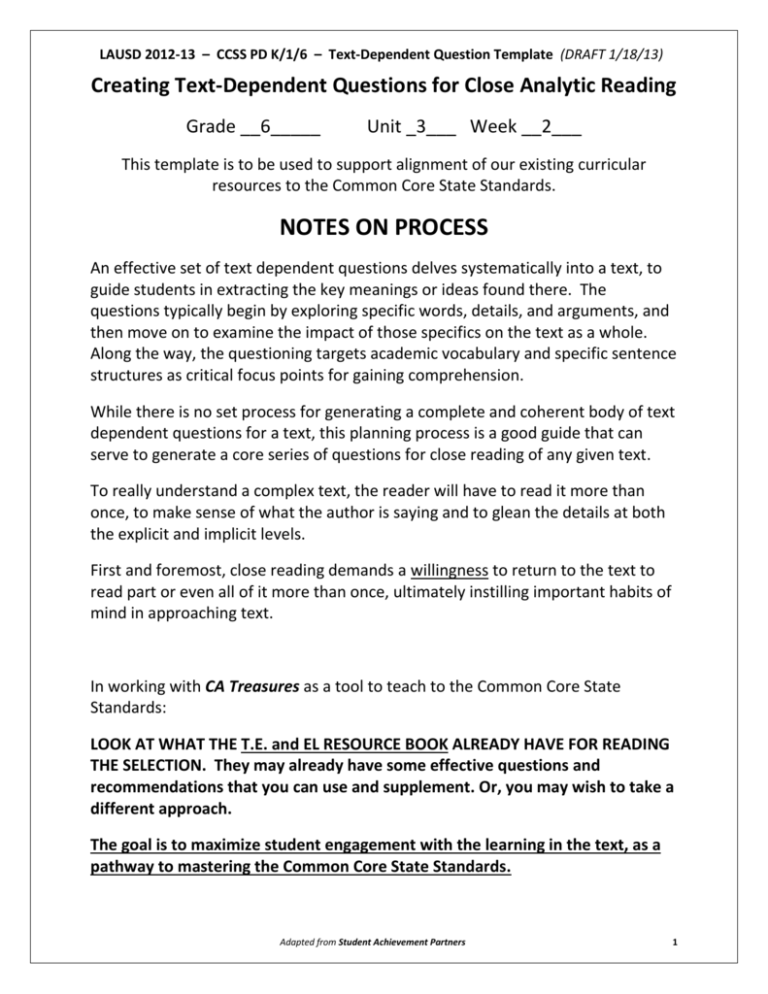
LAUSD 2012-13 – CCSS PD K/1/6 – Text-Dependent Question Template (DRAFT 1/18/13) Creating Text-Dependent Questions for Close Analytic Reading Grade __6_____ Unit _3___ Week __2___ This template is to be used to support alignment of our existing curricular resources to the Common Core State Standards. NOTES ON PROCESS An effective set of text dependent questions delves systematically into a text, to guide students in extracting the key meanings or ideas found there. The questions typically begin by exploring specific words, details, and arguments, and then move on to examine the impact of those specifics on the text as a whole. Along the way, the questioning targets academic vocabulary and specific sentence structures as critical focus points for gaining comprehension. While there is no set process for generating a complete and coherent body of text dependent questions for a text, this planning process is a good guide that can serve to generate a core series of questions for close reading of any given text. To really understand a complex text, the reader will have to read it more than once, to make sense of what the author is saying and to glean the details at both the explicit and implicit levels. First and foremost, close reading demands a willingness to return to the text to read part or even all of it more than once, ultimately instilling important habits of mind in approaching text. In working with CA Treasures as a tool to teach to the Common Core State Standards: LOOK AT WHAT THE T.E. and EL RESOURCE BOOK ALREADY HAVE FOR READING THE SELECTION. They may already have some effective questions and recommendations that you can use and supplement. Or, you may wish to take a different approach. The goal is to maximize student engagement with the learning in the text, as a pathway to mastering the Common Core State Standards. Adapted from Student Achievement Partners 1 LAUSD 2012-13 – CCSS PD K/1/6 – Text-Dependent Question Template (DRAFT 1/18/13) NOTES ON PLANNING STEPS THOUGH STEP 1 IS ALWAYS THE STARTING POINT, AND THE STEPS ARE NUMBERED, THE PROCESS FOR DEVELOPING A LESSON IS RECURSIVE. Step 1: Identify the Core Understandings and Key Ideas of the Text As in any good backward mapping process, teachers should start by identifying the key insights they want students to understand from the text. Keeping in mind the major points to be made is crucial for crafting an overarching set of successful questions. This step is also critical for creating an appropriate task to check for understanding. Step 2: Target Vocabulary Locate the most powerful words in the text that are connected to the key ideas and understandings. Craft questions that draw students’ attention to these specifics so they can become aware of these connections. Vocabulary selected for focus should be academic words and high-utility words that are abstract and likely to be encountered in future reading and studies. Needs of English Learners, SELs and SWDs should be a major focus in planning, e.g., contrastive analysis, vocabulary strategy practice, cognate connections, tiering vocabulary, clarifying common multiple-meaning words, vocabulary choices for particular registers, etc. Step 3: Syntax & Text Structures - Tackle Tough Sections of the Text Find the sections of the text that will present the greatest difficulty, and craft questions that support students in mastering these sections. These could be sections with difficult syntax or text structure, use of the passive voice, particularly dense information, tricky transitions, or places that offer a variety of possible inferences. This is another opportunity to engage contrastive analysis strategies, e.g., L1-L2 phrasing, analyzing passive & active voice structures, translation from home language(s) to school and academic language, contexts for use of particular registers, etc. Step 4: Create Coherent Sequences of Text Dependent Questions – Start Small to Build Confidence The opening questions should help orient students to the text, and be specific enough to answer so students gain confidence. The sequence of questions should not be random but should build toward more coherent understanding and analysis to ensure that students learn to stay focused on the text to bring them to a gradual understanding of its meaning. Think of ways to maximize student engagement. Step 5: Identify the Standards That Will Be Addressed in the Whole Lesson Take stock of what standards are being addressed in the series of questions and decide if any other standards are suited to being a focus. Form additional questions to exercise those standards. Step 6: Create a Task to Check for Understanding Develop a task around the key ideas or understandings identified earlier that: Reflects mastery of one or more of the key objectives of the lesson, involves writing, and is structured to be completed by students independently. Adapted from Student Achievement Partners 2 LAUSD 2012-13 – CCSS PD K/1/6 – Text-Dependent Question Template (DRAFT 1/18/13) Grade ___6____ Unit __3__ Week ___2__ Step 1: Identify the Core Understandings & Key Ideas of Text Selection Title: Rumpelstiltskin’s Daughter by Diane Stanley Original TE Big Question for Unit (Unit planning page __240/241______): What values are important to your culture? Enhanced Big Question (if applicable): Step 1 – Identify Core Understandings and Key Ideas of Text How do values represent what people believe and guide the way people live? Selection Concept(s) - Each selection builds to a larger understanding of the Big Question. How does this selection connect to the Big Question? Hope can be a social/ cultural belief that good will outweigh bad, and there will be positive outcomes. CCSS Focus Standard(s) ______________ What CCSS literacy standard(s) will you be addressing with this re-read of the selection? RL6.1, RL6.2, RL6.3, RL6.4, RL6.5 Selection Question - Connect the CCSS Focus Standard to the Selection Concept(s) in the form of a question: How do the plot development and the characters’ responses lead the reader to understand the sense of hope and belief in positive outcomes held by Rumpelstiltskin’s daughter? Does the comic tone and idiomatic phrasing also contribute to the sense of positivity? Adapted from Student Achievement Partners 3 LAUSD 2012-13 – CCSS PD K/1/6 – Text-Dependent Question Template (DRAFT 1/18/13) Steps 2 & 3: Target Vocabulary, Syntax, and Text Structure TEACHER PROVIDES DEFINITION Not enough clues provided in the text STUDENTS FIGURE OUT THE MEANING Sufficient context or word structure clues text Step 2 - Target Needed Vocabulary Step 2 - Target Needed Vocabulary KEY WORDS ESSENTIAL TO UNDERSTANDING THIS TEXT Pg 277 279 282 285 Words miller apoplectic portcullis sheepishly Clues/Supports root word: mill Pg 277 279 280 280 282 282 282 282 285 286 288 Words whopper bolted goldsmith devoted gnashing clutching peering moat prospered sumptuous hobbled Clues/Supports from French context clues compound word root word HIGH UTILITY WORDS FOR LANGUAGE DEVELOPMENT – Words ELs & all students need, to access this and other learning Pg Words Clues/Supports 279 coincidences 282 shifty eyes 282 iota 287 phase 291 prime minister Pg 279 279 281 Words pinkie-ring Little League red-hot minute Clues/Supports hyphenated word idiom context clues context clues context clues Adapted from Student Achievement Partners 4 LAUSD 2012-13 – CCSS PD K/1/6 – Text-Dependent Question Template (DRAFT 1/18/13) Step 3 – Challenging Syntax & Text Structures Idioms are used throughout this fairytale parody. The idioms add to the humorous style and add visual imagery. Some examples are: Heap of trouble Page277 This time he added a little sugar to sweeten the pot. Page 279 In a red-hot minute… Page 281 What she saw broke her heart. Page 281 She saw a pile of straw as big as a bus. Page 282 She put two thoughts together and cooked up a plan. Page 282 The selection is a parody of a fairy tale; it is a humorous imitation of a particular literary style. Humor is an important element in the text. Some examples are: I’ll be an excellent father. I know all the lullabies. I’ll read to the child every day. I’ll even coach Little League. Page 279 He blushed all the way from the top of his head to the tip of his toes (which admittedly wasn’t very far because he was short). Page 280 I like your ideas on parenting, you’d make a good provider, and I have a weakness for short men. Page 280 Adapted from Student Achievement Partners 5 LAUSD 2012-13 – CCSS PD K/1/6 – Text-Dependent Question Template (DRAFT 1/18/13) Step 4 - Craft questions that start small, address vocabulary, and build toward the key understandings and standards Step 4: Create Coherent Sequences of Text-Dependent Questions Text-Dependent Questions Evidence-Based Answers The author writes on page 277 that the main character was in a “heap of trouble”. Paraphrase what this trouble is. The girl’s father liked to make up stories. One of the stories he liked to pass on was that his daughter could turn straw into gold. This was not true. He said this within the hearing of a palace servant, who passed the information on to the king. The king had the girl brought to the palace, and demanded that she spin a roomful of straw into gold. If she didn’t accomplish the task she would be put to death. The selection is a parody of the fairy tale, Rumpelstilskin. A parody is a humorous imitation of a serious piece of literature. Some answers might include: Using evidence from the text find elements of parody on pages 279-281. “By one of those unlikely coincidences so common in fairy tales…” “This time she gave him her paper-band pinkie ring.” “I’ll even coach Little League.” “He blushed all the way from the top of his head to the tip of his toes (which admittedly wasn’t very far because he was short).” “In a red-hot minute she was in a carriage and speeding toward the palace.” The selection also uses a number of idioms for comic effect. An idiom is a phrase that means something different from what it literally says. Identify idioms in the text on page 282. “She saw a pile of straw the size of a bus.” What is the main problem for Rumpelstiltskin’s daughter? What are sentences that sum up the problem on page 282 and 283? The main problem is the King’s greed and obsession with gold. No matter how much gold her father spins for the king, it will never be enough. The text states on page 282, “One room full of gold would never satisfy him.” On page 283, the King exclaims, “But I want more!” On page 282, the text describes her thinking about the poor farmers and their hungry children, with thin sad faces. Her plan will involve helping these people, which speaks to her kind character. She is hopeful and optimistic that she will outsmart the king, and help to solve some of the problems of the villagers. Her plan had the king giving gold coins to the farmers “to plant”. Page 285 describes all the food that was harvested by the farmers, after investing the gold coins the king gave them in seeds and supplies. This is a positive outcome. On page 285, the author describes the king ready to “turning purple”, indicating anger when he receives no gold. He says The text gives us insight into the daughter’s character through her thoughts and the plan she comes up with. Based on what is said in the text what kind of person is she? Was her plan successful? What in the text indicates the king’s reaction to the farmers’ food and not the gold he expected? “She knew her father could get her out of this pickle.” Adapted from Student Achievement Partners 6 LAUSD 2012-13 – CCSS PD K/1/6 – Text-Dependent Question Template (DRAFT 1/18/13) sheepishly that he is hoping “there will be gold at the next place.” How does Rumpelstiltskin’s daughter’s next plan reinforce her kindness and hopefulness? Is the king changed by the plans devised by Rumpelstiltskin’s daughter? The author reveals Rumpelstiltskin’s daughter’s name in the last sentence. What is it? Why does it fit the character? Page 288 describes how the daughter has the king load the coaches with “knitting needles, a bag of gold, and lots of yellow wool.” Her plan is to have the king give these items to all the grannies. “Tell her to knit it all up and you will come back in a month to collect your riches. Give her a gold coin for her pains.” The result of her plan was warm clothes for the villagers. Page 288 describes the crowds of happy villagers waiting to greet the king, and “every one of them was warm as toast in yellow wooly clothes.” The daughter tells him now that “your people love you”, all the soldiers, the walls and moat and crocodiles can be gotten rid of, and he does so. He uses the stones to build a zoo and houses for the poor. She is rewarded with the position of prime minister and “whenever the king started worrying about gold, she sent him on a goodwill tour throughout the countryside, which cheered him up.” Her name is Hope. It is fitting in that she was in a difficult situation with the king, being asked to produce something out of her ability. But, she remained consistent and hopeful with plans to create positive outcomes for the villagers. Adapted from Student Achievement Partners 7 LAUSD 2012-13 – CCSS PD K/1/6 – Text-Dependent Question Template (DRAFT 1/18/13) Step 5: Standards Addressed in the Whole Lesson Step 5 – Identify Standards Being Addressed in Lesson A single lesson can cover multiple standards RL6.1, RL6.3, RL6.4, RL6.5 W6.3a-e, W6.4, W6.5, W6.6 L6.1a-e, L6.2, L6.3, L6.4d, L6.5a-c, L6.6 SL6.1a-d, SL6.4, SL6.5 URL Step 6: Create a Task to Check for Understanding http://www.readwritethink.org Describe task and steps students will take to achieve them. Step 6 – Task to Check for Understanding /files/resources/interactives /fairytales/ Prompt = Teacher instructions to students: Rumpelstiltskin’s Daughter is a parody of a fairy tale. It is a humorous spin on a serious piece of literature. The author also uses idioms and word play to add comedy and vivid imagery to the piece. With your team, collaborate to produce a written parody of a well-known fairy tale. Include the use of idioms and puns to create a humorous spoof on a classic narrative. There was a lesson on hope in Rumpelstiltskin’s Daughter. The daughter’s name was Hope, and she modeled that value by thinking that good things are there to be discovered, even in a challenging situation. In your group’s parody, include a learning on a value that is important to American culture. Task & Steps: In groups of 3-4, students will select, read, and write a summary of a well-known fairy tale. Students will identify the value or moral in the original piece. That same value/moral must be evident in the new piece. First drafts must include the original’s main characters, and be organized in a sequence of events that unfold naturally and logically and imitates the structure of the original plot. Dialogue, description, idiomatic expressions, and strong characterization must be evident and contribute to a close imitation of the original piece while providing a comic tone. The value to be learned must be apparent in the conclusion, and is logically gained from the narrated story. With guidance and support from peers and adults, groups will strengthen their writing through revisions and editing. Final drafts will be illustrated and produced in a book form. Adapted from Student Achievement Partners 8 LAUSD 2012-13 – CCSS PD K/1/6 – Text-Dependent Question Template (DRAFT 1/18/13) Present and read in a “fairy tale theatre” the final draft. Adapted from Student Achievement Partners 9 LAUSD 2012-13 – CCSS PD K/1/6 – Text-Dependent Question Template (DRAFT 1/18/13) Additional Tasks – (optional) Ex: to supplement or build toward culminating task; provide additional depth, complexity, novelty or acceleration for advanced students; make content connections; etc. Students may choose to perform their adapted fairy tale parodies, with costuming and staging used. They may also choose to videotape these presentations. Notes to Teacher Ex: Which sections of text to focus on for particular teaching points; considerations for grouping; content connections, supplemental resources or links Student Engagement – What format or strategies will give students the opportunities to actively engage with the learning? Break the students up in small groups (three to four) and assign a role-playing task to highlight different circumstances in the text. The students must plan and then act out a short scenario, which illustrates the text to the group. Have students be responsible to create Right There and Think and Search Questions from the QAR protocol. Allowing time to formulate and write questions and responses to ask classmates allows the information to be processed. Stop the reading and discussion of the story and have students do a quick write (“What do you think about the course of events in the plot?” “What makes this phrase comical?”) Below is a website for Fractured Fairy Tales, presenting more samples of a comedic spin on well-known fairy tales. These are useful for teaching point of view, setting, plot, as well as fairy tale conventions. This tool encourages students to use their imaginations and the writing process at the same time. http://www.readwritethink.org/classroom-resources/student-interactives/fractured-fairy-tales-30062.html Adapted from Student Achievement Partners 10 LAUSD 2012-13 – CCSS PD K/1/6 – Text-Dependent Question Template (DRAFT 1/18/13) Adapted from Student Achievement Partners 11
